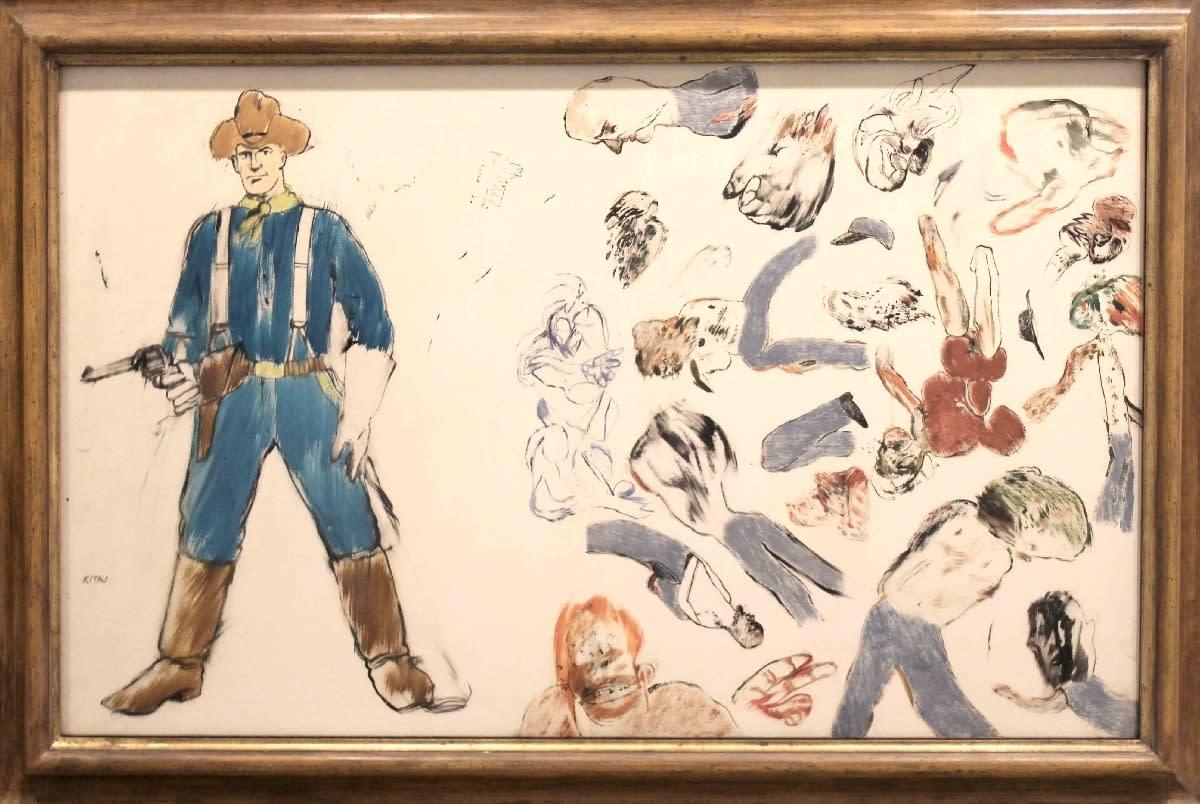R.B. Kitaj 1932-2007
The Bells of Hell, 1961
Oil on canvas
91.7 x 132 cms
36 1/16 x 51 15/16 ins
36 1/16 x 51 15/16 ins
3289
Sold
Considered by Kitaj to be one of his most important early Pop Art paintings, The Bells of Hell dates from a key moment in the artist's career and in the...
Considered by Kitaj to be one of his most important early Pop Art paintings, The Bells of Hell dates from a key moment in the artist's career and in the formation of British Pop Art.
Kitaj was one of the most sophisticated and iconographically complex artists of the last half-century, combining physicality with intellect in paintings whose complex themes often needed explicating by the artist in accompanying texts. An American in London, he was initially identified as a pioneer of Pop Art before recontextualising himself as a School of London painter alongside admired contemporaries that included Andrews, Auerbach, Bacon, Freud and Kossoff. Although Kitaj later sought to downplay his relationship to Pop Art, he did acknowledge the significance of the present work. In 2007 Kitaj wrote about this painting: 'I guess its one of the very few pictures with a Pop aura about it....' (Kitaj, email to James Hyman, 9 July 2007).
The Bells of Hell is a rare example of Kitaj's Pop Art style. A bold, direct image, it is also distinctive in being so overtly about America and Amerian history. The colours reference the American flag, the subject depicts an important event in American history - General Custer and the Battle of Little Bighorn - and the imagery overtly borrows symbolic motifs from American-Indian pictographs.
Kitaj inspiration was an 1893 Smithsonian Institute study of pictographs of the Battle of Little Big Horn, as Marco Livingstone has observed:
'Kitaj quotes literally from the illustrations in the Smithsonian in order to produce a modern version of a historical narrative picture, one that deals with an actual event... both through the eyes of contemporary witnesses and from the perspective of an artist living a century later.' (Marco Livingstone, Kitaj, London 1999, p.14)
In 1959, two years before painting the present work, Kitaj enrolled at the Royal College of Art in London, the crucial period for British Pop Art. There he became a close friend and early mentor of David Hockney and was part of a Pop Art generation that included Derek Boshier, Patrick Caulfield and Allen Jones.
In The Bells of Hell Kitaj boldly adopts the formal aspects of his source to bisect the picture and disregards conventional perspective and spatial arrangements in an emphasis on the front plane which also addresses the modernist concerns of his New York School compatriots. However, in its daringly expressive fractured figuration it also suggests a European context in its evocation of the fragmented bodies of Francis Bacon, whom Kitaj praised in one of his very first pieces of published writing.
Kitaj, himself, paticularly admired the right hand side of the work and its figures inform several of his later paintings: The right hand side is quite interesting because it was taken from some extraordinary American Indian images which appeared in some very important publication of the Smithsonian Institute which appeared around the turn of the last century showing battle details.' (Kitaj, email to James Hyman, 9 July 2007). The scattered bodies and body parts of Bells of Hell are reprised, for example, in two of Kitaj's most important later paintings: If Not, Not (1975-76) and Rock Garden (The Nation) (1981).
Kitaj was one of the most sophisticated and iconographically complex artists of the last half-century, combining physicality with intellect in paintings whose complex themes often needed explicating by the artist in accompanying texts. An American in London, he was initially identified as a pioneer of Pop Art before recontextualising himself as a School of London painter alongside admired contemporaries that included Andrews, Auerbach, Bacon, Freud and Kossoff. Although Kitaj later sought to downplay his relationship to Pop Art, he did acknowledge the significance of the present work. In 2007 Kitaj wrote about this painting: 'I guess its one of the very few pictures with a Pop aura about it....' (Kitaj, email to James Hyman, 9 July 2007).
The Bells of Hell is a rare example of Kitaj's Pop Art style. A bold, direct image, it is also distinctive in being so overtly about America and Amerian history. The colours reference the American flag, the subject depicts an important event in American history - General Custer and the Battle of Little Bighorn - and the imagery overtly borrows symbolic motifs from American-Indian pictographs.
Kitaj inspiration was an 1893 Smithsonian Institute study of pictographs of the Battle of Little Big Horn, as Marco Livingstone has observed:
'Kitaj quotes literally from the illustrations in the Smithsonian in order to produce a modern version of a historical narrative picture, one that deals with an actual event... both through the eyes of contemporary witnesses and from the perspective of an artist living a century later.' (Marco Livingstone, Kitaj, London 1999, p.14)
In 1959, two years before painting the present work, Kitaj enrolled at the Royal College of Art in London, the crucial period for British Pop Art. There he became a close friend and early mentor of David Hockney and was part of a Pop Art generation that included Derek Boshier, Patrick Caulfield and Allen Jones.
In The Bells of Hell Kitaj boldly adopts the formal aspects of his source to bisect the picture and disregards conventional perspective and spatial arrangements in an emphasis on the front plane which also addresses the modernist concerns of his New York School compatriots. However, in its daringly expressive fractured figuration it also suggests a European context in its evocation of the fragmented bodies of Francis Bacon, whom Kitaj praised in one of his very first pieces of published writing.
Kitaj, himself, paticularly admired the right hand side of the work and its figures inform several of his later paintings: The right hand side is quite interesting because it was taken from some extraordinary American Indian images which appeared in some very important publication of the Smithsonian Institute which appeared around the turn of the last century showing battle details.' (Kitaj, email to James Hyman, 9 July 2007). The scattered bodies and body parts of Bells of Hell are reprised, for example, in two of Kitaj's most important later paintings: If Not, Not (1975-76) and Rock Garden (The Nation) (1981).
Provenance
Marlborough Fine Art, LondonIvor Braka, London
Private Collection, Europe
Exhibitions
A Tribute to Sir Colin St John Wilson, James Hyman Gallery, 2007Kitaj Memorial Gallery, Summer Exhibition, The Royal Academy, 2008
Celebrating 175 Years of the RCA, Royal College of Art, 2012-2013
Literature
Kestner-Gesellschaft, Hannover, R B Kitaj, 1970, (cat. no. 105, detail illustrated)Marco Livingstone, Kitaj, 1985 (no.12, plate 26)
Richard Wollheim, 'Kitaj: Recollections and Reflections' in (ed. Richard Morphet), R.B.Kitaj: A Retrospective, Tate Gallery, 1994 (illustrated p.40, misdated 1960 and described as whereabouts unknown)
Join our mailing list
* denotes required fields
We will process the personal data you have supplied to communicate with you in accordance with our Privacy Policy. You can unsubscribe or change your preferences at any time by clicking the link in our emails.


